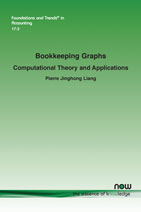Bookkeeping Graphs: Computational Theory and Applications
By Pierre Jinghong Liang, Carnegie Mellon University, USA and University of Hong Kong, Hong Kong, liangj@andrew.cmu.edu
Abstract
This monograph first describes the graph or network representation of Double-Entry bookkeeping both in theory and in practice. The representation serves as the intellectual basis for a series of applied computational works on pattern recognition and anomaly detection in corporate journal-entry audit settings. The second part of the monograph reviews the computational theory of pattern recognition and anomaly detection built on the Minimum Description Length (MDL) principle. The main part of the monograph describes how the computational MDL theory is applied to recognize patterns and detect anomalous transactions in graphs representing the journal entries of a large set of transactions extracted from real-world corporate entities’ bookkeeping data.
Bookkeeping Graphs: Computational Theory and Applications
Bookkeeping Graphs: Computational Theory and Applications first describes the graph or network representation of Double-Entry bookkeeping both in theory and in practice. The representation serves as the intellectual basis for a series of applied computational works on pattern recognition and anomaly detection in corporate journal-entry audit settings. The second part of the monograph reviews the computational theory of pattern recognition and anomaly detection built on the Minimum Description Length (MDL) principle. The main part of the monograph describes how the computational MDL theory is applied to recognize patterns and detect anomalous transactions in graphs representing the journal entries of a large set of transactions extracted from real-world corporate entities’ bookkeeping data.
